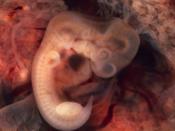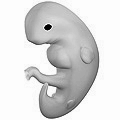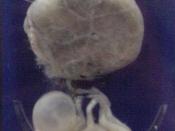Fetal Development
Mugs Blank
Anatomy/Physiology
October 1, 2001
Mr. Going
�
Fetal development starts with the process of fertilization. It starts when the female ovulates producing an egg. This egg then travels into the fallopian tube where it waits to be fertilized. Once sperm enter the body they must travel up the uterus until they make their way up to the egg.
Once at the egg the sperm try to get in. They sperm wiggle their tails until they make it in. Once it makes it in the egg will not any other sperm in. The sperm that made it then drops its tail. After about twenty hours inside the egg the sperm finds the nucleus of the egg and fuses with it. Now the egg has all the genetic material that it needs to make a new human being.
It now begins to move down into the uterus. The egg is now called a blastocyst.
The time that this takes is often measured after the last menstrual period (LMP). The time is also measured in trimesters, three month intervals. After about thirty hours the cell divides for the first time. It is continuously moving towards the uterus where it will call home for the next nine months. After about two days it has divided to having about eight cells. After four days it is in the uterus and has to "land" somewhere and attach itself to the endometrium.
The eighth day is when implantation occurs. The fertilized egg then implants itself on the endometrium, the uterine lining, and begins to grow. The cell begins to grow and develop. By the 12th day the blastocyst has approximately two thousand cells in it. It has had time to attach itself to the endometrium and these anchors are called protuberances.
After about...


